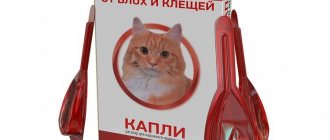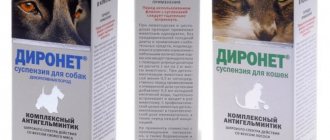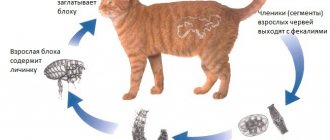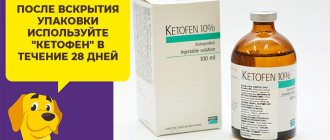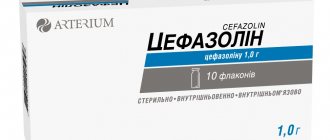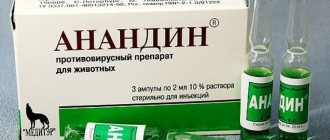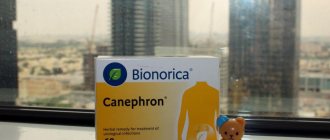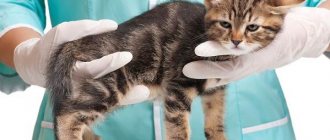Composition and pharmacological properties.
Anandin eye drops and intranasal drops in 1 ml contain glucaminopropylcarbacridone (anandin) - 20 mg.
Used in complex therapy of conjunctivitis and rhinitis of various etiologies in dogs and cats. Glucaminopropylcarbacridone (anandine) belongs to the group of synthetic low-molecular-weight cytokine inducers, has anti-inflammatory and wound-healing effects, stimulates the production of endogenous interferon, increases the functional activity of T-lymphocytes and macrophages, and activates the production of anti-inflammatory cytokines.
Description of the drug
Anandin is used to treat conjunctivitis and rhinitis in cats
Anandin drops are intended for the treatment of acute and chronic conjunctivitis, rhinitis and inflammation of the sinuses. The drug is a transparent light green liquid with a faint medicinal odor. The medicine contains glucoaminopropylacridone and auxiliary components (distilled water and glycerol). The drops are non-toxic, low-hazard substances and are sold without a prescription. The sterile drug is packaged in 5 ml glass bottles. Each bottle is closed with a rubber cap and wrapped in aluminum foil. The drops are packaged in a box and supplied with detailed instructions. The cost of 1 bottle is about 50 rubles.
Annadine is an immunomodulator. Drops suppress inflammatory processes, accelerate wound healing, and help destroy harmful bacteria and viruses. The drug can be used together with other medications and is often included in a complex treatment system. It is noted that the drops are especially effective at the onset of the disease.
Another type of drops is available - Anandin Plus. This drug is intended for the treatment of orthodectosis (ear form of scabies), elimination of bacterial and fungal infections. The composition includes anandin (glucaminopropylcarbacridone), permethrin, gramicidin C, and isoprapanol, castor oil and distilled water as auxiliary components. Transparent light yellow liquid is packaged in plastic dropper bottles.
Anandin Plus is low-toxic, it is not dangerous for warm-blooded animals, but can harm fish and bees.
Doses and order of application.
For conjunctivitis, the drug is instilled in 2-3 drops behind the lower eyelid twice a day, for rhinitis - 2-4 drops in each nasal passage two to three times a day. Treatment is carried out until the animal recovers, but not more than 14 days. The drops are compatible with other medications and feed additives. Avoid skipping the next dose of the drug, as this may lead to a decrease in therapeutic activity. If one dose is missed, the use of the drug is resumed at the same dose and according to the same regimen.
Reviews about the drug
Cat owners talk about the effectiveness of drops
Inga: I picked up my kitten on the street. It is clear that we had to get rid of worms and fleas, and the baby’s eyes were not all right. The veterinary pharmacy recommended Anandin and said that it removes pus well. And indeed, on the third day the eyes cleared up, the discharge decreased, and then disappeared completely. The cat did not experience any discomfort and did not even struggle during the burial. The drug is good, tested.
Konstantin: We have a white Persian cat, she constantly has problems with her eyes. The doctor says chronic conjunctivitis. And what is especially unpleasant is that the cat cannot tolerate many medications, the eyes turn red, and watery eyes begin to bleed. During the next exacerbation I decided to try these drops, the reviews seem to be quite good. I liked that there was no irritation or pain, the cat tolerated the procedure calmly. I took the course and my eye seemed to improve. Now I will use it as needed, especially since the drops are inexpensive.
Tatyana: This was my first time encountering rhinitis in a cat. The doctor decided that it was an allergic phenomenon. He prescribed antihistamine injections and Anandin as a concomitant remedy. Together the drugs worked great. In 4 days the cat recovered completely and became happier. It is not very convenient to put it into the nose, and the bottle leaves much to be desired. I would prefer a plastic bottle with a dispenser. The price is very affordable, which is nice.
Side effects.
Side effects and complications when using the drug in accordance with the instructions, as a rule, are not observed.
In case of increased individual sensitivity to the active components of the drug or an overdose, it should be washed off with water and detergent and the animal should be prescribed antihistamines and symptomatic drugs.
Special studies on pregnant and lactating animals have not been conducted. The possibility of using Anandin eye drops and intranasal drops for females during pregnancy and feeding the offspring is determined by the attending physician based on an assessment of the ratio of benefits to the possible risk of using the drug.
Advantages and contraindications
The main advantage of the drug is its low price and availability.
The advantages of the drug include:
- high tolerance by animals;
- no side effects;
- non-toxic;
- compatibility with other drugs;
- ease of use;
- can be used for kittens, pregnant and lactating cats;
- low price;
- availability.
The drug has virtually no contraindications . The only problem may be individual intolerance to anandin or glycerol, which is rare. If an allergic reaction is detected, antihistamines may be prescribed. There are no complete analogues on sale.
Anandin Plus drops should not be used if the eardrum is damaged. It is necessary to avoid getting the drug on the cat's fur and mucous membranes.
Storage conditions
The medicine Anandin is stored at room temperature (up to 25 C), in tightly closed packaging, protected from light and moisture, far from food. After all necessary manipulations with the product, you must wash your hands thoroughly with soap. The shelf life of Anandin from the date of manufacture, subject to all storage conditions, is 2 years.
Research by veterinarians and scientists has already proven that the medical drug Anandin for cats is an effective medicine and preventive measure that protects the health of our beloved little brothers.
Anandin - video instructions
Visit the profile section of our Medical Examination forum or leave your feedback in the comments below. More opinions means more useful information, it will be useful to someone. If there are good and interesting videos on the topic of the article, write and I will insert them into this publication.
How to properly treat a cat with Anandin: tips
In order to increase the effectiveness of Anandin forms such as ointment and drops, it may be necessary to pre-clean the application site. Thus, wounds on the skin must first be cleaned of blood and pus; the same is done when instilled into the ears or eyes. If dirt, purulent discharge, or dead skin flakes have accumulated in the animal’s ears, the area needs to be treated. To do this, apply a chlorhexidine solution or saline solution to a cotton or gauze swab, which is used to carefully clean the treated area. The same applies to eye drops - before dripping them, if necessary, you need to rinse the animal's eyes.
Pre-cleaning
The next stage is the actual use of the drug. To do this, the animal must be restrained. Some will need the help of a second person, while others can handle it themselves if they wrap the cat in a thick towel or other fabric, making it impossible to move. After you have applied the ointment or instilled the drug, you need to hold the pet in your arms for some time, not allowing you to shake your head or lick the damaged area.
To prevent your cat from being afraid of the procedure, you can give her something tasty.
As for injections, not every person can give a cat an injection at home. In any case, for the first time you need to do this under the guidance of a veterinarian, who will tell you how to administer the drug intramuscularly and monitor the correctness of the actions. In any case, treat your cat with care and kindness!
Video - Putting medicine in a cat's ears
Possible complications
If the requirements and dosages specified in the instructions for the drug are strictly followed, there are no side effects or pathological complications. There is also no data on overdoses during treatment with Anandin.
Antibiotics in the form of drops for infectious eye diseases
Arutimol eye drops - instructions for use and when to prescribe
The definition of paralytic strabismus and treatment methods in adults and children are described here.
This article will tell you what false myopia or accommodation spasm is.
pharmachologic effect
Anandin has a wide range of biological effects. The drug is recommended for the treatment of the following diseases of cats: 1. Acute, chronic bacterial and viral infections. Anandin suppresses the action and reproduction of almost all types of DNA and RNA genomic viruses (for example, viral hepatitis, polioencephalitis, all forms of canine distemper, etc.), staphylococcal endemics and various fungal infections. 2. Complications after suffering from severe viral diseases of various localizations (neurotropic, pantropic, dermatropic and other viruses). 3. Inflammatory diseases. 4. Slowing down regenerative processes. 5. Complex immunodeficiency conditions provoked by bacterial flora. The drug promotes the formation of T and B cells of the cat’s immune defense.
Anandin ear drops for the treatment of otitis in dogs and cats 5 ml
Anandin ear drops are antibacterial drugs for auricular use.
The active components included in the drug provide its antimicrobial and anti-inflammatory effect in the affected area.
Gramicidin C is a polypeptide antibiotic for topical use. It has a bacteriostatic effect, is active against streptococci, staphylococci, causative agents of anaerobic infections and a number of other, mainly gram-positive, microorganisms. In high concentrations it has a bactericidal effect, increases the permeability of the microbial cell membrane, which causes the death of microorganisms.
The antibiotic is slightly absorbed by the mucous membranes, which provides a local antimicrobial effect of the drug.
Glucaminopropylcarbacridone (anandine) - belongs to the group of synthetic low-molecular cytokine inducers, stimulates the production of endogenous interferon, has immunomodulatory, anti-inflammatory activity, helps reduce inflammatory processes, heal damaged tissues, and reduces itching.
Anti-inflammatory activity is ensured by enhancing the functional activity of neutrophils and activating phagocytosis.
Based on the degree of impact on the body, Anandin ear drops are classified as low-hazard substances (hazard class 4 according to GOST 12.1.007-76), and do not have a locally irritating, resorptive-toxic or sensitizing effect.
Application procedure
Anandin ear drops are used to treat acute and chronic inflammation of the external auditory canal (otitis externa) of bacterial etiology in dogs and cats.
A contraindication for use is the animal’s increased individual sensitivity to the components of the drug (including a history of it).
The use of Anandin ear drops for the treatment of otitis media due to perforation of the eardrum is prohibited.
The drug is used in dogs and cats by applying it to the external auditory canal of the ear, instilling 2-4 drops two to three times a day. Treatment is carried out for 4-7 days until the animal’s clinical recovery. If necessary, the course of treatment is repeated.
Before using the drug, in order to avoid contact of the cold solution with the animal’s ear, it is recommended to warm the bottle in the palms of your hands.
No symptoms of drug overdose have been identified in dogs and cats.
The specific effects of the drug upon its first use and withdrawal have not been established.
Avoid skipping the next dose of the drug, as this may lead to a decrease in therapeutic effectiveness. If one dose is missed, the drug should be resumed as soon as possible, at the same dose and according to the same regimen.
As a rule, there are no side effects or complications when using drops in accordance with these instructions. In case of increased individual sensitivity of the animal to the components of the drug and the appearance of allergic reactions, the use of Anandin ear drops is stopped and, if necessary, the animal is prescribed antihistamines.
The use of Anandin ear drops does not exclude the use of other drugs for pathogenetic and symptomatic therapy.
Drops are not intended for use in productive animals.
Personal prevention measures
When working with ear drops, you should follow the general rules of personal hygiene and safety precautions provided for when working with medications.
People with hypersensitivity to the components of the drug should avoid direct contact with Anandin. If the drug accidentally comes into contact with the skin, it should be washed off immediately with soap and water; if it gets into the eyes, rinse them for several minutes with running water. If allergic reactions occur or if the drug accidentally enters the human body, you should immediately contact a medical facility (bring with you the instructions for use of the drug or the label).
It is prohibited to use empty drug bottles for household purposes. They are placed in a plastic bag and disposed of with household waste.
Analogs and reviews
At the moment, Anandin has no analogues among drugs used in veterinary medicine. At the same time, reviews about the medicine are very diverse: from enthusiastic to extremely negative. An important role in this case is played by the fact that many owners, hoping for the versatility of the drug and the absence of contraindications, purchase and use it themselves. To avoid side effects and to ensure your pet’s recovery and not a worsening of its condition, you must show the animal to a veterinarian before using the product.
Indications for use
Anandin is used in traditional veterinary medicine for the treatment of chronic, acute ophthalmological diseases, rhinitis of various etiologies. The frequency of use and the duration of the treatment course are prescribed by the attending veterinarian!
For cats and dogs, the veterinary drug is prescribed as a complex therapy:
- viral, bacterial rhinitis;
- serous, catarrhal, purulent, allergic conjunctivitis;
- uveitis;
- rhinitis;
- rhinotracheitis.
Ear drops are used for otitis, ear mites (otodectosis), for the prevention of ear diseases of viral, allergic, bacterial, parasitic etiology.
Conjunctivitis in a dog, initial stage
Anandin is used for the treatment and prevention of viral, bacterial, and fungal diseases in animals (canine distemper, infectious hepatitis, mycoses, encephalitis). It can be prescribed as a therapeutic agent for complications caused by bacterial flora, as well as for weakened cats to strengthen the immune system, increase the body's resistance to dogs that have had infectious diseases.
